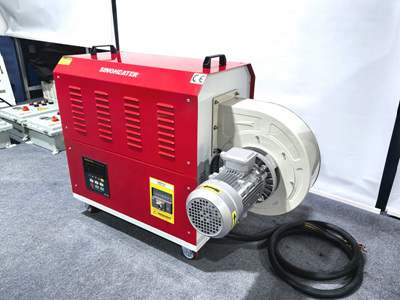A tightening inspection guide for hot air blowers after use in Vibrating environments
After long-term operation in a vibrating environment (such as industrial production lines, mobile equipment, construction sites, etc.), mechanical vibration can easily cause loosening of fasteners and displacement of components, which in turn can lead to equipment failure, increased noise and even safety accidents. To ensure the stable operation of the equipment, regular systematic tightening checks should be carried out. The following provides professional guidance from four aspects: preparation before inspection, core fastening parts, inspection methods and standards, and subsequent maintenance.
First, preparations before inspection
Safety protection
Power-off operation: Turn off the power supply and hang a “Do Not Close the Switch” warning sign to prevent electric shock or accidental start-up.
Equipment fixation: If the hot air blower is installed on a mobile platform or bracket, the equipment must be fixed first to prevent shaking during inspection.
Protective equipment: Wear anti-slip gloves and goggles to prevent tools from slipping or parts from splashing and injuring people.
Second, core fastening parts and inspection methods
Motor and fan assembly
Inspection area:
Motor fixing bolts (4 to 6 pieces, M8 to M10)
Fan blade fastening nuts (usually M6 to M8)
The connection flange bolts between the motor and the air duct
Inspection method:
Use a torque wrench to check the torque of each bolt one by one according to the manufacturer’s standard (for example, M8 bolts require 15 to 20N·m).
Observe whether the fan blades are shaking. If the gap is greater than 0.5mm, the blades need to be re-tightened or replaced.
Case: A hot air blower in a certain factory caught fire due to the loosening of the fan nut, which caused the blades to rub against the air duct, resulting in a loss of over 100,000 yuan.
2. Bracket and installation base
Inspection area:
Expansion bolts (M10 to M12) between the support and the ground/wall
The connecting bolts between the bracket and the main body of the hot air blower
Inspection method:
Shake the equipment manually to check if the bracket shakes.
Use a torque wrench to verify the torque of the expansion bolts (for example, M12 bolts require 50 to 60N·m). If they are loose, they need to be re-tightened and anti-loosening washers added.
3. Electrical connection and control box
Inspection area:
Terminal block bolts (M4~M6)
Sensor fixing bolts (such as temperature sensors)
Inspection method:
Gently pull the wire to confirm that the terminal blocks are not loose.
Tighten the sensor bolts with a screwdriver to prevent signal interruption caused by vibration.
4. Air duct and filter screen assembly
Inspection area:
Air duct connection clamp
Filter screen fixing frame bolts
Inspection method:
Check whether the clamps are deformed or loose and replace them if necessary.
The bolts of the filter screen frame need to be reinforced with thread locking agent to prevent them from falling off due to vibration.
Third, repair measures
Loosening repair measures
Slightly loose
Re-tighten to the standard torque and apply the thread locking agent (such as Loctite 243).
Severe loosening or damage
Replace the bolts and install anti-loosening washers (such as spring washers or double self-locking washers).
If the bracket is deformed, it needs to be corrected or replaced.
Fourth, record management
Establish the “Hot Air Blower Fastening Inspection Record Form” and record the following information:
Inspection date, inspector, and description of the vibration environment (such as vibration frequency and amplitude).
Loose parts, repair measures, and replacement parts list.
Check the plan next time.
Fifth, Precautions
Prohibited behavior:
It is strictly prohibited to use excessive torque to tighten bolts to prevent the threads from slipping or breaking.
It is prohibited to inspect the electrical connection parts without power off.
Professional disassembly
If it is necessary to disassemble the motor or complex components, it is recommended to have it done by professionals to avoid damaging the equipment.
Vibration monitoring
For high-frequency vibration environments, it is recommended to install vibration sensors to monitor vibration data in real time and issue early warnings of loosening risks.
Sixth, Summary
The fastening inspection of the hot air blower after its use in a vibrating environment should follow the principle of “power off first, then inspect, and finally repair”. Through scientific inspection and tightening, the mechanical failure rate can be reduced by more than 80%, and the service life of the equipment can be extended by 2 to 3 times. If abnormal vibration or noise still exists after inspection, the machine should be stopped immediately and professional personnel should be contacted for maintenance to avoid safety accidents.
Through the above methods, the stable operation of the hot air blower in a vibrating environment can be ensured, guaranteeing production safety and efficiency.



